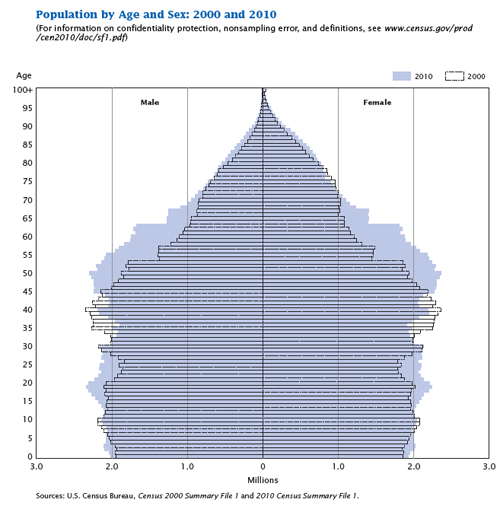Shauna Hill for 314 Intermedia
Nothing is forever and we all tend to look back and remember "when" now and again. Even young ones in the sixth grade look back at the way things were in the primary grades. Some changes around us are small (but still significant) and others are so large it's hard to grasp their meaning.
America is changing right before our eyes — it's a large, sweeping, and difficult-to-grasp change that is altering the way we do almost everything, especially marketing! The main indicator of this change can be found in our demographics. There were about 333 million Americans in the year 2022; and our numbers are growing. By 2050 there will probably be 400 million of us. During the 1990's the number of children ages 5 to 13 grew to more than 36 million; the 14 to 17 year olds grew to 15.7 million. Most of them make up the more than 23 million young adults in the work force today. That's a good size group of young people, but it pales beside the largest demographic group. America is not a nation of young people. We are aging. The median age of the nation shifted from 32.8 years old in 1991 to 36.5 in 2022. Our dramatic increase in median national age is caused by the aging of our largest demographic group: the Boomers.
Baby boomers (as they have been called) are those born 1946 to 1962. This group of Americans has dominated our demographic landscape and shaped our marketing since Harry S. Truman was President. But they are clearly no longer babies ... they are fast becoming gray headed seniors. In 2011, a boom in seniors started and will last for 20 years. By the year 2010 Americans aged 65 and older totaled 39.5 million. They will grow to 69.8 million by 2030. All other groups (children, Gen X, Gen Y, etc.) forming the other 30 million consumers will be overshadowed by this huge wealthy, bubble of seniors.
How will this change marketing? Well, most noticeably marketing campaigns will no longer target traditional family units (father, mother, and children) because they have been decreasing and will continue to decrease. In 1970, 81% of households were traditional family units; by 1992 the percentage of family units decreased to 70% and by 2010 family units represented only 68% of the U.S. population. American households are increasingly be formed of non-traditional family units (single parent, grandparent headed families). But there will be many other changes in marketing also.
Marketing will need to reflect not only the shifts in demographics but also the shifting psychographics. Values are going to change along with the changing demographics. The greatest value shift is expected to be from moral indifference to a search for new moral standards. Perhaps the most telling indicators of this shift was the immense popularity of the book titled "A Purpose Driven Life" and how riveted boomers were to the Florida court case concerning the woman on a feeding tube. Boomers by the millions are seeking meaning and moral standards that reflect their values concerning quality of life, family ties and respect for the earth. Our gray headed boomers are not looking to retire soon or gracefully (nor have they prepared for it). They are fighting aging at all costs and remaining active in work and play for as long as they can.
From today until after 2030, the predominant issues of this nation are going to be the preoccupations of the aging boomers, namely: increased quality of life, moral standards, balancing family and work, health, and personal meaning.
What does this mean for your marketing campaign? Precision Intermedia has done extensive work to answer that question for a variety of industries and professions. We are prepared to advise you on a solid approach to reaching both the majority (seniors) and the minority (all other age groups) now and in the future.
If you would like more information about marketing, please contact us.
Nothing is forever and we all tend to look back and remember "when" now and again. Even young ones in the sixth grade look back at the way things were in the primary grades. Some changes around us are small (but still significant) and others are so large it's hard to grasp their meaning.
 |
| The average age of U.S. citizens is steadily rising. How will this affect your marketing strategy? |
Baby boomers (as they have been called) are those born 1946 to 1962. This group of Americans has dominated our demographic landscape and shaped our marketing since Harry S. Truman was President. But they are clearly no longer babies ... they are fast becoming gray headed seniors. In 2011, a boom in seniors started and will last for 20 years. By the year 2010 Americans aged 65 and older totaled 39.5 million. They will grow to 69.8 million by 2030. All other groups (children, Gen X, Gen Y, etc.) forming the other 30 million consumers will be overshadowed by this huge wealthy, bubble of seniors.
How will this change marketing? Well, most noticeably marketing campaigns will no longer target traditional family units (father, mother, and children) because they have been decreasing and will continue to decrease. In 1970, 81% of households were traditional family units; by 1992 the percentage of family units decreased to 70% and by 2010 family units represented only 68% of the U.S. population. American households are increasingly be formed of non-traditional family units (single parent, grandparent headed families). But there will be many other changes in marketing also.
Marketing will need to reflect not only the shifts in demographics but also the shifting psychographics. Values are going to change along with the changing demographics. The greatest value shift is expected to be from moral indifference to a search for new moral standards. Perhaps the most telling indicators of this shift was the immense popularity of the book titled "A Purpose Driven Life" and how riveted boomers were to the Florida court case concerning the woman on a feeding tube. Boomers by the millions are seeking meaning and moral standards that reflect their values concerning quality of life, family ties and respect for the earth. Our gray headed boomers are not looking to retire soon or gracefully (nor have they prepared for it). They are fighting aging at all costs and remaining active in work and play for as long as they can.
From today until after 2030, the predominant issues of this nation are going to be the preoccupations of the aging boomers, namely: increased quality of life, moral standards, balancing family and work, health, and personal meaning.
What does this mean for your marketing campaign? Precision Intermedia has done extensive work to answer that question for a variety of industries and professions. We are prepared to advise you on a solid approach to reaching both the majority (seniors) and the minority (all other age groups) now and in the future.
If you would like more information about marketing, please contact us.




